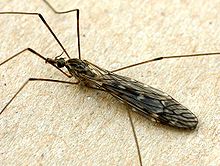Limoniinae
| Limoniinae | |
|---|---|
 |
|
| Limonia nubeculosa | |
| Scientific classification | |
| Kingdom: | Animalia |
| Phylum: | Arthropoda |
| Class: | Insecta |
| Order: | Diptera |
| Suborder: | |
| Infraorder: | Tipulomorpha |
| Superfamily: | Tipuloidea |
| Family: | Tipulidae |
| Subfamily: | Limoniinae |
| Genera | |
|
see text |
|
| Diversity | |
| ca. 150 genera | |
see text
The Limoniinae are a paraphyletic assemblage of genera within the crane flies, Tipulidae, although they can usually be distinguished by the way the wings are held at rest. Limoniines usually hold/fold the wings along the back of the body, whereas other tipulids usually hold them out at right angles. Members of the genus Chionea (snow flies) have no wings at all. Limoniines are also usually smaller than other tipulids, with some exceptions. Limoniinae are a very large assemblage with nearly 10500 described species in 133 genera, and were historically treated as a subfamily, but their classification is in flux; numerous authors recently treated the group at the rank of family, but subsequent phylogenetic analyses revealed that the remaining groups of tipulids render the group paraphyletic. These flies are found in damp places throughout the world, and many species form dense swarms in suitable habitats.
For terms see Morphology of Diptera
Limoniines are medium or small-sized, rarely large. The proboscis or rostrum lacks a beak. The apical segment of the maxillary palpi is short and never longer than subapical one. The antennae are, in most species, 14- or 16-segmente (rarely 6-, 10-, or 17-segmented), usually verticillate (whorls of trichia) and only exceptionally ctenidial or serrate (Rhipidia). There is a distinct V-shaped suture between the mesonotal prescutum and scutum (near the level of the wing bases). The wings are monochromatic or punctate and (in females more often than in males). sometimes shortened or reduced. The subcosta always fuses with the costa through Sc1. Radial vein R2 does not fuse with the costa, as in most other Tipulidae, but with radial vein R3. The radial sector Rs has one or two forks.Additional crossveins are sometimes present in cells r3 an1 and m. Cells m1 and d often not present. The genitalia of males have large separated gonocoxis and one or two pairs of appendages which are sometimes greatly folded (Dicranomyia, etc.). The ovipositor of the female has sclerotized cerci.
Mostly, larvae are aquatic or semi-aquatic. Most other Tipulidae larvae in comparison, are terrestrial though some are aquatic and found in huge numbers in lotic habitats like the limoniine larvae. Various species have evolved to feed on different food sources, so phytophagous, saprophagous, mycetophagous and predatory species occur.
...
Wikipedia
